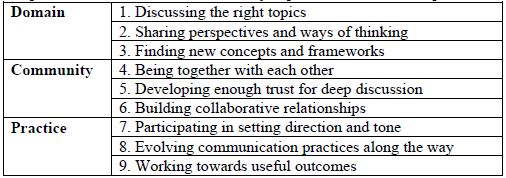In the beginning I found it a bit overwhelming what was coming at me. I also had to get used to planning the online synchronous sessions and the preparations. In combination with a family, work and other activities it took some time to manage it. I think this is an aspect of studying part-time students also experience. So undergoing such an online adventure yourself is very instructive!
Getting started
As a learner at first I was still a bit insecure about what to expected of ONL192 and what ONL was expecting of me. It was also exciting how my PBL group should be. Participants in our group come from all over the world: Sweden, England, South Africa and Switzerland (and The Netherlands). I liked the approach of this first week. It didn’t go into depth yet, but we were working on a good foundation for the upcoming weeks full of community learning.

Table 1 Community barometer (Smith & Coenders, 2002)
Based on the theory of community learning (Smith & Coenders, 2002), this first week we paid particular attention to the components of ‘community’ (see table 1). Creating mutual involvement (Wenger, 1998), solidarity (Duncan-Howell, 2010) and a safe and good atmosphere is essential for participation in an online community (Prenger, Poortman & Handelzalts, 2017). We’ve been working on that.
Another aspect that is important in this phase of building our PBL community was the support of the facilitators. I think as a condition for running an online community this role is underexposed. Looking at the aspects of Table 1, the facilitator ensures that the course is determined with regard to discussing the right topics and ‘setting direction and tone’ (Smith & Coenders, 2002). Especially in this initial phase, the facilitator gives direction to our learning process as a group.
Motivation to participate in ONL192
In the educational institution where I work, we are in the process of introducing a new educational model. An important part of this model is ‘community learning’. From my work as an Instructional Designer, I am interested in the question of what contribution online communities can make to the learning process of students.

I read quite a lot of literature about community learning. The best way to give advice is from your own experience.
I see opportunities and possibilities to use online community learning as a professionalisation intervention for teachers. It’s good to experience it by myself.
Here I am at ONL192!
Resources
Duncan-Howell, J. (2010). Teachers making connections: Online communities as a source of professional learning. Britisch Journal of Educational Technology, Vol 41(2), 324-340
Prenger, R., Poortman, C.L., & Handelzalts, A. (2017). Factors influencing teachers’ professional development in networked professional learning communities. Teaching and Teacher Education 68 (2017) 77e90
Smith, J.D. & Coenders, M. (2002). E-feedback to reflect legitimate peripheral participation. Towards a redefinition of feedback in online learning environments. In AACE, 2002.
Wenger, E. (1998). Communities of Practice: Learning, Meaning and Identity. Cambridge: Cambridge University Press.